Reading data in an ODBC application
In this section we will learn how to configure and use Gmail Connector in the API Driver to extract data from the Gmail.
Create ODBC Data Source (DSN) based on ZappySys API Driver
Step-by-step instructions
To get data from using we first need to create a DSN (Data Source) which will access data from . We will later be able to read data using . Perform these steps:
-
Download and install ODBC PowerPack.
-
Open ODBC Data Sources (x64):
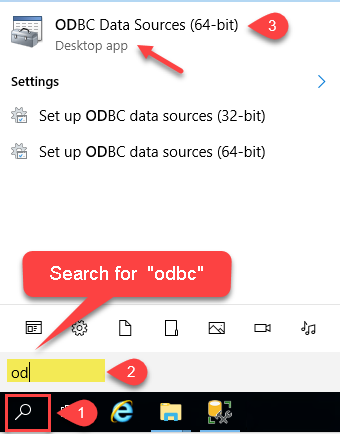
-
Create a User data source (User DSN) based on ZappySys API Driver:
ZappySys API Driver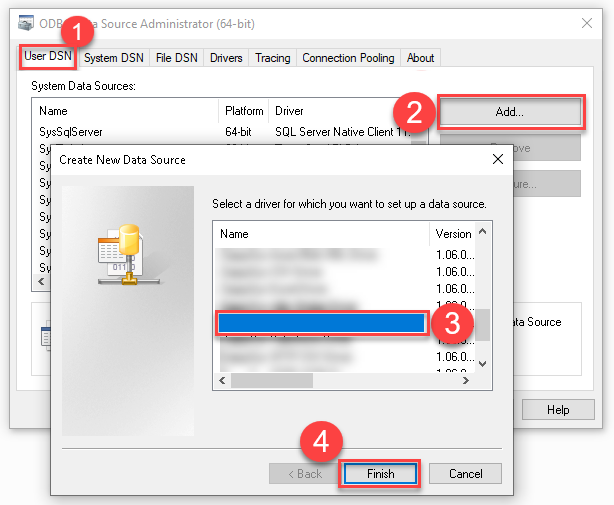
-
Create and use User DSN
if the client application is run under a User Account.
This is an ideal option
in design-time , when developing a solution, e.g. in Visual Studio 2019. Use it for both type of applications - 64-bit and 32-bit. -
Create and use System DSN
if the client application is launched under a System Account, e.g. as a Windows Service.
Usually, this is an ideal option to use
in a production environment . Use ODBC Data Source Administrator (32-bit), instead of 64-bit version, if Windows Service is a 32-bit application.
-
Create and use User DSN
if the client application is run under a User Account.
This is an ideal option
-
When the Configuration window appears give your data source a name if you haven't done that already, then select "Gmail" from the list of Popular Connectors. If "Gmail" is not present in the list, then click "Search Online" and download it. Then set the path to the location where you downloaded it. Finally, click Continue >> to proceed with configuring the DSN:
GmailDSNGmail
-
Now it's time to configure the Connection Manager. Select Authentication Type, e.g. Token Authentication. Then select API Base URL (in most cases, the default one is the right one). More info is available in the Authentication section.
Gmail authentication
To make this work you will have to create a Google Cloud project. This project forms the basis for creating, enabling, and using all Google Cloud services, including managing APIs, enabling billing, adding and removing collaborators, and managing permissions.
- Go to the Google Cloud Console
- In the Google Cloud console, go to menu IAM & Admin, and then Create a Project.
- Enter the name of the new project into the Project Name field and select the appropriate organization, then click Create.
- The console navigates to the Dashboard page and your project is created within a few minutes.
- In the Google Cloud console, go to menu More products, Google Workspace, and then Product Library.
- Now we need to enable the Gmail API.
- Search for Gmail API. Select it and then click ENABLE.
- Select the Credentials tab on the left side of the screen.
- Select the + CREATE CREDENTIALS link to reveal a drop down menu.
- In the dropdown menu, select OAuth client ID.
- If presented, click the CONFIGURE CONSENT SCREEN button and then elect the appropriate User Type based on your business needs. Otherwise, continue to step 16.
- In the OAuth consent screen tab fill in your app's website and domain information, and then click SAVE AND CONTINUE.
- In the Scopes section of the app registration, click ADD OR REMOVE SCOPES and add the following scopes:
- openid
- https://mail.google.com/
- https://www.googleapis.com/auth/userinfo.email
- https://www.googleapis.com/auth/userinfo.profile
- https://www.googleapis.com/auth/gmail.labels
- https://www.googleapis.com/auth/gmail.send
- https://www.googleapis.com/auth/gmail.modify
- https://www.googleapis.com/auth/gmail.compose
- https://www.googleapis.com/auth/gmail.readonly
- After the scopes have been added, click SAVE AND CONTINUE.
- Complete the wizard setting up scopes.
- Select the Credentials tab on the left side of the screen.
- Select the + CREATE CREDENTIALS link to reveal a drop down menu.
- In the dropdown menu, select OAuth client ID.
- In the Application type drop down, select Desktop application and then give your app client a name.
- Select the CREATE button.
- A popup window will appear that provides important information you should record for your records:
- Client ID
- Client secret
- Go to OAuth Consent Screen tab. Under Publishing Status click PUBLISH APP to ensure your refresh token doesnt expire often. If you planning to use App for Private use then do not have to worry about Verification Status after Publish.
- Back to Connection UI, Enter the client ID and client secret into the required parameters.
API Connection Manager configuration
Just perform these simple steps to finish authentication configuration:
-
Set Authentication Type to
User Account [OAuth] - Optional step. Modify API Base URL if needed (in most cases default will work).
- Fill in all the required parameters and set optional parameters if needed.
- Press Generate Token button to generate the tokens.
- Finally, hit OK button:
GmailDSNGmailUser Account [OAuth]https://gmail.googleapis.com/Required Parameters UseCustomApp Fill-in the parameter... Authorization URL Fill-in the parameter... Token URL Fill-in the parameter... Default API Version Fill-in the parameter... Default User Id Fill-in the parameter... Scope Fill-in the parameter... Optional Parameters Client Id Client Secret RetryMode RetryWhenStatusCodeMatch RetryStatusCodeList 429 RetryCountMax 5 RetryMultiplyWaitTime True Redirect URL (Only for Web App) 
-
Once the data source connection has been configured, it's time to configure the SQL query. Select the Preview tab and then click Query Builder button to configure the SQL query:
 ZappySys API Driver - GmailRead / search Gmail messages, download attachments, send mail and more using Gmail REST API.GmailDSN
ZappySys API Driver - GmailRead / search Gmail messages, download attachments, send mail and more using Gmail REST API.GmailDSN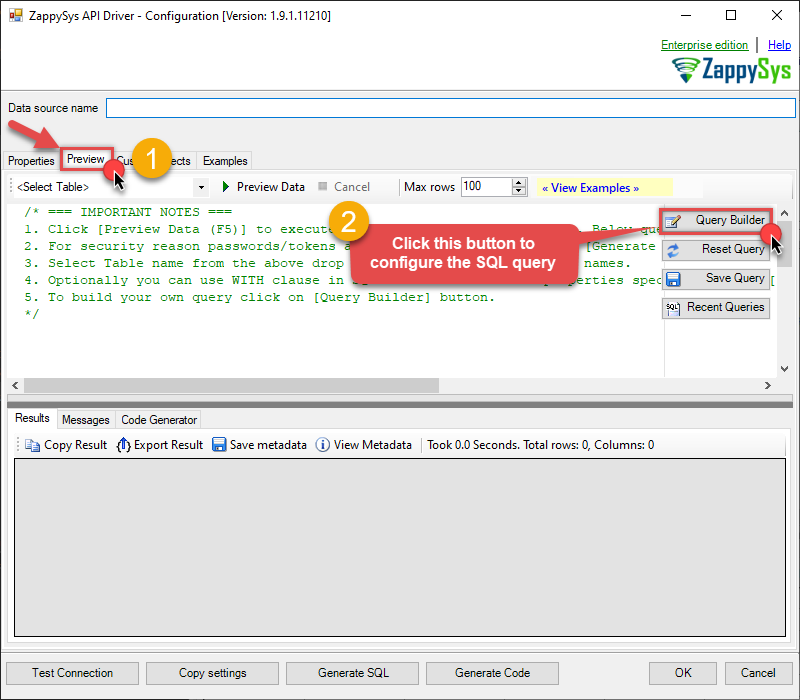
-
Start by selecting the Table or Endpoint you are interested in and then configure the parameters. This will generate a query that we will use in to retrieve data from Gmail. Hit OK button to use this query in the next step.
SELECT * FROM Messages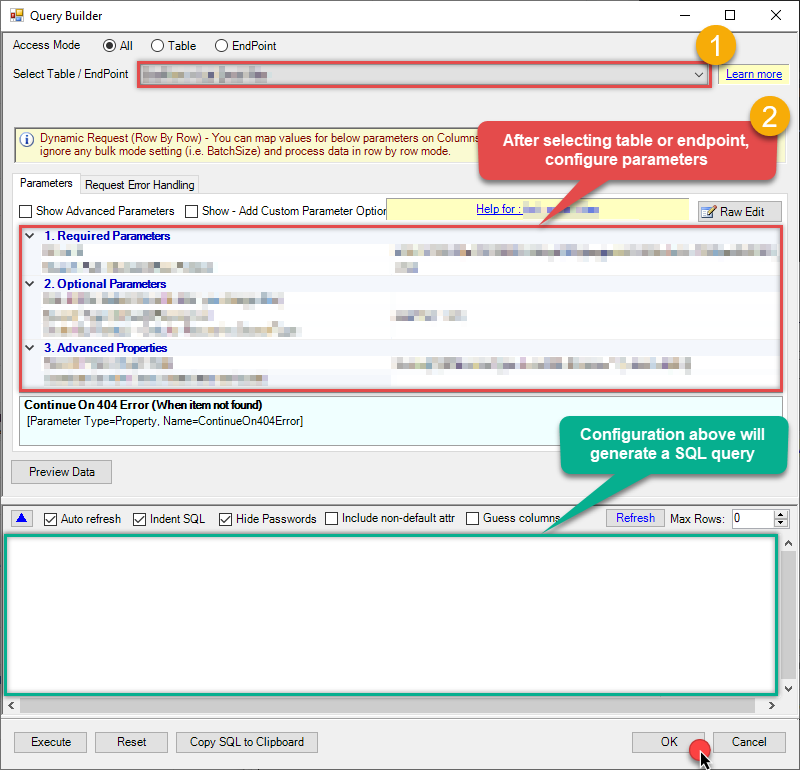 Some parameters configured in this window will be passed to the Gmail API, e.g. filtering parameters. It means that filtering will be done on the server side (instead of the client side), enabling you to get only the meaningful data
Some parameters configured in this window will be passed to the Gmail API, e.g. filtering parameters. It means that filtering will be done on the server side (instead of the client side), enabling you to get only the meaningful datamuch faster . -
Now hit Preview Data button to preview the data using the generated SQL query. If you are satisfied with the result, use this query in :
 ZappySys API Driver - GmailRead / search Gmail messages, download attachments, send mail and more using Gmail REST API.GmailDSN
ZappySys API Driver - GmailRead / search Gmail messages, download attachments, send mail and more using Gmail REST API.GmailDSNSELECT * FROM Messages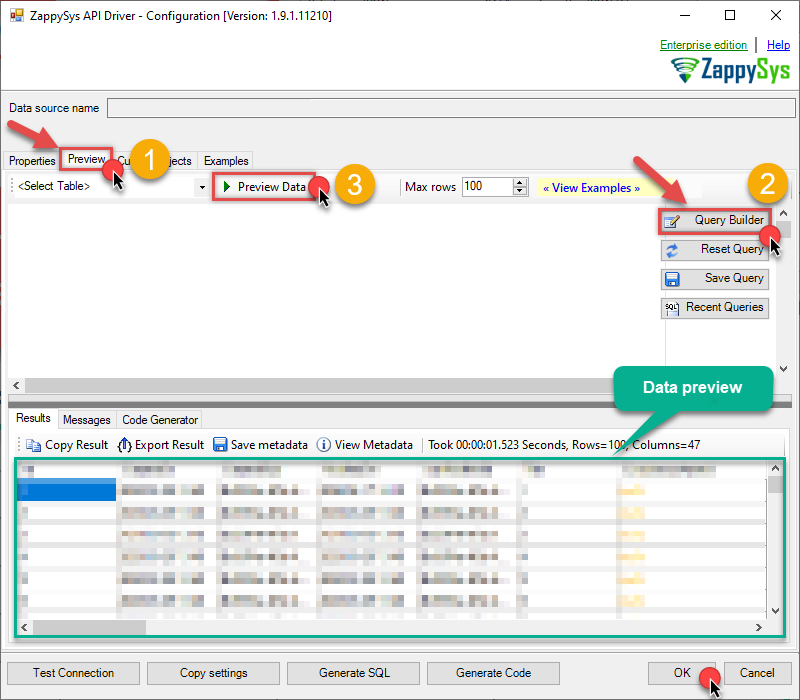 You can also access data quickly from the tables dropdown by selecting <Select table>.A
You can also access data quickly from the tables dropdown by selecting <Select table>.AWHEREclause,LIMITkeyword will be performed on the client side, meaning that thewhole result set will be retrieved from the Gmail API first, and only then the filtering will be applied to the data. If possible, it is recommended to use parameters in Query Builder to filter the data on the server side (in Gmail servers). -
Click OK to finish creating the data source.
Video Tutorial
Reading Gmail data from client application
- Firstly, to get data from ODBC data source based on ZappySys ODBC driver, in your client application, you would need to connect to ODBC source and then from the list select the data source.
-
Finally, to read the data just read tables/views in your app or enter a SQL statement to extract data, e.g.:
SELECT * FROM Messages
Gmail Connector Examples
The ZappySys API Driver is a user-friendly interface designed to facilitate the seamless integration of various applications with the Gmail API. With its intuitive design and robust functionality, the ZappySys API Driver simplifies the process of configuring specific API endpoints to efficiently read or write data from Gmail.
Click here to find more Gmail Connector examples designed for seamless integration with the ZappySys API ODBC Driver under ODBC Data Source (36/64) or ZappySys Data Gateway, enhancing your ability to connect and interact with Prebuilt Connectors effectively.
Consume Data inside your App / Programming Language
Once you know how to load data from Gmail Connector, you can click on one of the below links to learn the steps how to consume data inside your App / Programming Language from Gmail Connector.ODBC inside ETL / Reporting / BI Tools
- Power BI
- Tableau
- Excel
- Informatica PowerCenter
- QlikView
- SQL Server / Linked Server
- SSRS (SQL Server Reporting Services)
ODBC inside Programming Languages
Key features of the ZappySys API Driver include:
The API ODBC driver facilitates the reading and writing of data from numerous popular online services (refer to the complete list here) using familiar SQL language without learning complexity of REST API calls. The driver allows querying nested structure and output as a flat table. You can also create your own ODBC / Data Gateway API connector file and use it with this driver.
Intuitive Configuration: The interface is designed to be user-friendly, enabling users to easily set up the specific API endpoints within Gmail without requiring extensive technical expertise or programming knowledge.
Customizable Endpoint Setup: Users can conveniently configure the API endpoint settings, including the HTTP request method, endpoint URL, and any necessary parameters, to precisely target the desired data within Gmail.
Data Manipulation Capabilities: The ZappySys API Driver allows for seamless data retrieval and writing, enabling users to fetch data from Gmail and perform various data manipulation operations as needed, all through an intuitive and straightforward interface.
Secure Authentication Integration: The driver provides secure authentication integration, allowing users to securely connect to the Gmail API by inputting the necessary authentication credentials, such as API tokens or other authentication keys.
Error Handling Support: The interface is equipped with comprehensive error handling support, ensuring that any errors or exceptions encountered during the data retrieval or writing process are efficiently managed and appropriately communicated to users for prompt resolution.
Data Visualization and Reporting: The ZappySys API Driver facilitates the seamless processing and presentation of the retrieved data from Gmail, enabling users to generate comprehensive reports and visualizations for further analysis and decision-making purposes.
Overall, the ZappySys API Driver serves as a powerful tool for streamlining the integration of applications with Gmail, providing users with a convenient and efficient way to access and manage data, all through a user-friendly and intuitive interface.